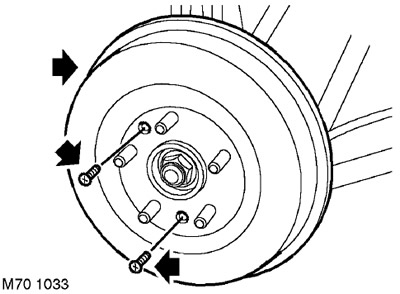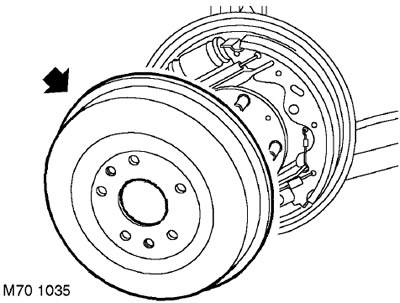Dismantling
1. Raise the rear of the vehicle.
WARNING: Do not work under a vehicle that is only supported by a jack. Always install safety props.
2. Remove the wheel.
3. Pull down the parking brake lever.

4. Turn away 2 screws of fastening of a brake drum and remove a brake drum.
NOTE: If the brake drum cannot be removed, increase the clearance between the brake shoes and the brake drum.

5. Remove the rubber gasket from the inside of the brake shield.
6. Using 2 slotted screwdrivers, release the retainer and turn the adjuster to increase the clearance between the brake shoes and the brake drum.

7. Remove the brake drum.
CAUTION: Do not use compressed air to clean brakes. Brake friction material particles can be harmful to the body if inhaled.
Installation
1. Replace the brake drum with a new one if its working surface is rough, or there are grooves or cracks on it.
2. Make sure the pistons can move freely in the wheel cylinder.
3. Clean the brake shield and brake drum with brake cleaner.
CAUTION: Do not use mineral based fluids. Their use may cause damage to the rubber elements.

4. Measure the inside diameter of the drum at 2 points. Drum inner diameter: New drum - 254 mm. The maximum allowable value is 255.49 mm. Permissible ovality - 0.012 mm. Replace the brake drum if it is oversized.
5. Inspect the protective covers of the wheel cylinder, paying attention to traces of leakage of brake fluid and their abnormal moisture. If a significant amount of brake fluid is found, lift the seals and check for leakage. Replace the wheel cylinders and brake pads with new ones if the linings are contaminated with brake fluid.
6. Use 111 molybdenum disulphide grease to lubricate contact points of brake pads and springs.
CAUTION: Be careful not to get grease on the brake pads and wheel cylinder protectors.
Check the adjuster lock and, if necessary, adjust the brake pads to ensure the minimum clearance. To do this, perform the following procedure: Remove the primary brake shoe from the wheel cylinder. Slide the regulator lock all the way back. Release the block to return it to its original position.
7. Establish a brake drum and wrap screws of its fastening.
8. If necessary, install the brake shield gasket.
9. Depress the brake pedal at least 30 times to ensure that the rear brake pads are fully adjusted after installation.
10. Check the operation of the parking brake lever and, if necessary, adjust it.
11. Replace the wheel (wheels) and tighten the nuts to a torque of 115 Nm.
12. Remove props and lower the car.
Comments on this article